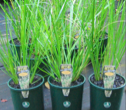Local North Queensland information for Local North Queenslanders.
Planting time is fraught with risks for young plants. They are wrenched from the warm caring environment of the nursery and sent out into the big bad world to make it on their own…
 How you ease your plants into their new environment plays a large part in determining whether they make it or not.
How you ease your plants into their new environment plays a large part in determining whether they make it or not.
Here’s a Few Important Tips:
- Preparing the soil:
Plants can’t grow if their roots can’t grow out into the surrounding soil. Therefore it is absolutely essential that the soil is thoroughly dug up and loosened before you even think about planting your plants. This is the single most important factor which will determine the success of your planting. - Digging the hole:
Once the soil is thoroughly prepared, all you need to do is dig a hole just a little larger than the pot the plant is in. If the soil is properly prepared, this should be a very easy job with a spade or even your bare hands. - Planting:
- Remove the plant gently from the pot by tipping it carefully upside down and sliding the pot off. Be very careful that the potting mix does not fall away from the roots. DO NOT TEASE THE ROOTS OUT. Teasing the roots is an old wives’ tale left over from a bygone era. Modern nursery technology ensures that you should never have to purchase a root-bound plant. In fact, pulling at the roots of native plants will most likely kill them, since you will be pulling off the fine feeder roots which absorb the water and nutrients.
- Place the plant gently in the hole so that the top of the root ball is just below the soil surface.
- Back-fill around the root-ball with fine friable soil.
- Gently firm the soil around the plant. DO NOT STOMP OR COMPACT THE SOIL.
- DO NOT add fertiliser to the hole. Yuruga’s plants have long-life fertiliser in the potting mix – plenty to last for a couple of months. It is incredibly easy to kill a young plant with fertiliser, and this is one of the major causes of death in new planting. Better to be safe than sorry, so DON’T FERTILISE WHEN PLANTING!
- Watering:
Water every plant as soon as you have planted it, with at least a bucket-full of water, even if it’s raining. It’s pretty unlikely that a shower of rain will amount to the equivalent of a bucketful of water – that’s many, many inches! So water even if it’s raining. Failure to water enough when you plant is the highest cause of death in new plantings. - Mulching:
Cover the soil around your plants with organic mulch. - Staking:
Avoid staking if possible since this only encourages weak stems and trunks. A light pruning is often all that’s needed to make a plant stand upright on its own, or alternatively prop it up with a log or rock so that there is still room for movement. Trunks will only strengthen if they are exposed to movement, so if staking is really necessary, tie the plant as loosely as possible, and remove the tie as soon as possible. If a tie is left around a trunk, it will ring bark and kill the tree.
For more information on the topics above, read the other leaflets in our comprehensive series of Information Sheet available at Yuruga Nursery.
When you get your plants home…
- Except for a few shady varieties such as ferns, Yuruga’s plants are totally sun-hardened when you buy them. Take them home and plant them out in the full sun straight away.
- There is absolutely NO NEED to keep your plants for a few weeks at your place in order to “acclimatise” them before planting.
- Do all your planning and preparation first, and buy your plants last. Get yourself organised so that you can plant them the same day you buy them.
If you cannot plant your plants straight away…
PLANTS MUST BE WATERED EVERY DAY WITHOUT FAIL.
Don’t rely on a sprinkler, and don’t wave the hose over the top – the water must thoroughly soak the potting mix in the pot. Failure to water plants kept in pots every day will almost certainly mean that they die.


Transporting your plants home:
- Plants must be transported in a covered vehicle. Plants carried on the back of an open ute or truck will suffer severe wind damage and it is essential that this be avoided.
- Up to 50 plants can usually be carried in any sedan, using either the boot or back seat. 20 plants (equivalent to 5 shopping bags) take up only 60 cm x 60 cm of space.
- If you have an open ute, bring a tarpaulin (with a suitable length of rope) to cover your plants or enough boxes to pack the plants in.

